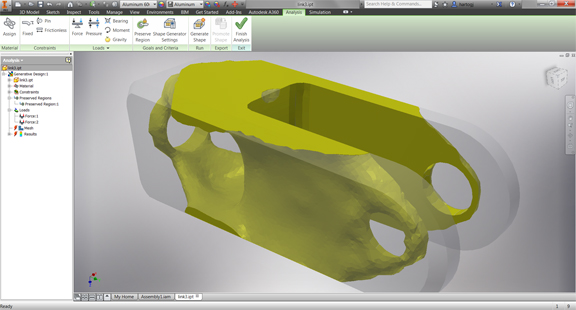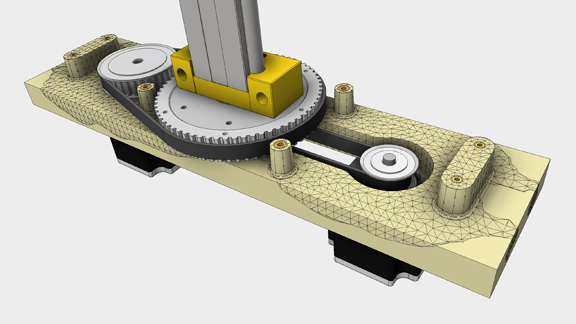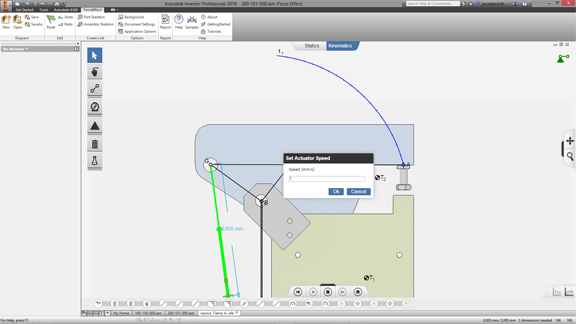
Autodesk Inventor update introduces Shape Generator, a topology optimization feature embedded in the CAD modeling environment.
Latest News
October 16, 2015
 Autodesk Inventor update introduces Shape Generator, a topology optimization feature embedded in the CAD modeling environment.
Autodesk Inventor update introduces Shape Generator, a topology optimization feature embedded in the CAD modeling environment. Shape Generator brings topology optimization into the early CAD design phase.
Shape Generator brings topology optimization into the early CAD design phase. Autodesk ForceEffect, previously available on iPad, is now brought into Inventor.
Autodesk ForceEffect, previously available on iPad, is now brought into Inventor.It’s a vision that Autodesk CTO Jeff Kowalski shared a year ago. Inside Mandalay Bay, speaking to the crowd at Autodesk University 2014, Kowalski said, “[It] starts with your goal. Then it explores all the possible permutations of the solution through successive generations, until the best one is found.” That sums up what Autodesk calls “Generative Design.”
A variant of Generative Design can be seen in Autodesk Within, which automatically generates lattice structures that fit user-defined geometric volumes. Another variant appears in the latest update to Autodesk Inventor as Shape Generator, a topology optimization function embedded in Inventor’s CAD modeling environment.
Like Autodesk Within, Shape Generator relies on Autodesk Nastran as its simulation engine to perform stress analysis behind the scene, then proposes the best—or optimal—geometry for the project. The geometry is optimized based on user input, such as loading condition, anticipated pressure, and targeted weight reduction threshold.
“Topology optimization has been around, used mainly by the analysts community with CAE (computer-aided engineering) tools or special tools. What’s different about this is, it’s integrated into a mainstream CAD platform,” said Jonathan den Hartog, a Autodesk product manager for Autodesk Inventor. “Our approach is to put it in CAD so it can benefit the conceptual design phase.”
Special software like solidThinking Inspire lets you perform topology optimization. Certain simulation and analysis packages also offer the function. However, it’s rarely integrated in general-purpose CAD programs. In that respect, Autodesk Inventor may be breaking new grounds with the introduction of Shape Generator. Introducing optimization at the CAD design phase brings the art of lightweighting closer to the conceptual design phase. In the initial incarnation, Shape Generator focuses on “structurally efficient lightweight parts,” explained Hartog.
Since Shape Generator is embedded inside Inventor, the user can overlay optimized geometry proposed by the software to the original part, making it easier to identify the regions where further trims and cuts can be made without affecting the part’s structural integrity. The way Shape Generator works is consistent with the way you’d use topology optimization in specialized CAE software, but with a simpler interface.
ForceEffect, previously available as an iPad app, also appears in this update as an integrated 2D simulation application. ForceEffect lets you draw 2D schematics of structures (such as bicycle frames or crane arms), apply loads, and quickly simulate the mechanical behaviors and stresses anticipated on the design. Previously users would perform such analyses on the mobile device and import the outcome into 3D CAD for further development. The integration of it into the desktop Inventor software consolidates the workflow into a single environment.
The update also addresses the mechanical-electrical data exchange with the IDF import option. Printed circuit board (PCB) designs are usually modeled in ECAD (electrical CAD) programs that support IDF. Inventor’s IDF import function allows you to bring in PCB designs in 3D into the mechanical modeling environment to verify spacing, placement, fitness, and clashes.
The new version represents a functionality update to Autodesk Inventor 2016. It also indicates the way Autodesk releases will work in the future. Instead of the rigidly defined annual releases, the company plans to issue updates whenever it has completed major R&D initiatives. Autodesk’s subscription licensing lays the groundwork for these periodic updates.
Subscribe to our FREE magazine, FREE email newsletters or both!
Latest News
About the Author
Kenneth Wong is Digital Engineering’s resident blogger and senior editor. Email him at [email protected] or share your thoughts on this article at digitaleng.news/facebook.
Follow DERelated Topics






